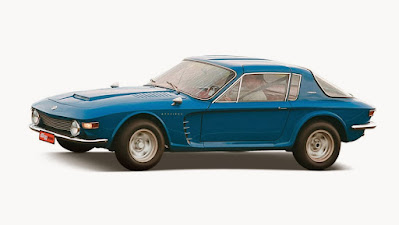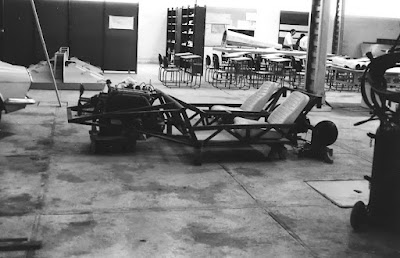ONE-OFF Maybe once upon a time it crossed our minds, did religious leaders or priests
ever get involved or even drown in the excitement of the world's automotive. In fact, there are many examples and we had already
discussed one of them here, namely
Father Alfred A. Juliano, a Catholic priest whose designed and built a weird-shaped concept car named the
Aurora Safety Car back in the mid-1950s.
 |
| The 1972 FEI X-3 Lavinia shooting-brake sports car concept featured with Dodge V8 engine designed and built by Rigoberto Soler and his FEI's student team. (Picture from: AutoEntusiastasClassic) |
 |
Roberto Sabóia de
Medeiros (1905-1955).
(Picture from: AllPar) |
Well now there's one more, a Jesuit priest and visionary
Roberto Sabóia de Medeiros realized that Brazil could no longer depend on just being an agrarian
country after World War II ended, and had to pave the way to become an industrialized country. For the such reason, he initiated the
Fundação de Ciências Aplicadas (FCA) or in English, the
Foundation of Applied Sciences in 1945, to aid in Brazil's industrialization; two years later, the foundation opened its
Faculdade de Engenharia Industrial (FEI) or
Faculty of Industrial Engineering in São Paulo.
 |
| The Brasinca 4500GT sports car built by Rigoberto Soler during 1964 to 1966 as many as 77 units, is powered by a six-cylinder Chevrolet engine. (Picture from: AutoEntusiastasClassic) |
Ten years later, spurred by Brazilian President Juscelino Kubitschek, Brazil's industrial revolution gained speed, especially in São Paulo,
with investments by numerous foreign automotive industries such International Harvester, Simca, Willys Overland, and General Motors. FEI opened a new campus in Sao Bernardo do Campo, thanks to a land donation by Lavinia Gomes, Mayor Lauro Gomes' wife.
 |
| The 1972 FEI X-3 shooting-brake sports car concept (on the left) posed along with its predecessor 1968 FEI X-1 (on the right). (Picture from: AutoEntusiastasClassic) |
In
1963, one key professor named
Rigoberto Soler was knows as a former
official of
ENASA (Empresa Nacional de Autocamiones), which made trucks
in the '50s for Francoist Spain and had built the
Pegaso sports car, led
by a former
Alfa Romeo technical director
Wilfredo Ricart. Previously during 1964 to 1966,
Soler had designed and built a sports car with a six-cylinder
Chevrolet engine named the
Brasinca 4200 GT as many as 77 units.
 |
Mockup of the FEI X-2 hovercraft, for use in rivers, swamps and wetlands; the project was not fully completed, having reached the testing phase with a wooden air-sliding platform, a propeller and no cabin. (Picture from: LexisCarBrasil)
|
Then within
FEI,
Soler led the
Department of Studies and Research Vehicles.
Their first car called the
FEI X-1, was a unique two-seater car based on the mechanicals of the
Renault
Gordini featured with hovercraft-fan at rear, and was first shown in 1968. This car is the forerunner of the
FEI X-2 model which was made as a real hovercraft which move without contact with the ground supported by air pockets.
 |
FEI's classroom with the X-3 side view (notice the curved floor), and Professor Soler, standing beside the desk. (Picture from: AutoEntusiastasClassic)
|
 |
Rigoberto Soler.
(1926-2004).
(Picture from: AllPar) |
|
In
1972,
Soler instructed his students to work on a unique-shaped sports
car in general called as the shooting brake, the
FEI X-3 'Lavinia' (as tribute to the
FEI benefactor), which would be an evolution
of the
4200 GT. For your info, the shooting-brake is a type of car design
that usually
comes with one door on each side, and a little boxy shaped at the rear,
where it might have one or two-opened doors. He specified the use of a tubular steel frame and air
brake, a rectangular flap embedded in the rear of the vehicle. The
students were divided into two groups, one responsible for manufacturing
the chassis and other bodywork.
Initially, for this concept car, Soler gave his students freedom to relate to the shape, dimensions, and components that will be used to build it as well. So this car then took its dimensions idea by taking a reference to the use of the Ford 292-cubic-inch V8 engined model. And the most of the components would be from the
Dodge Dart. While the front suspension was a Torsion Aire, with torsion bars;
though the Chrysler rear axle was supported by coil springs, more
suitable for a sports car. Fourteen-inch magnesium wheels were used; the
Gemmer steering box was the same as the Dart's but with its 24:1
reduction ratio changed to 15:1 to be more sensitive to high-speed
maneuvers.
 |
| The FEI X-3 chassis under construction featured with Ford front-engined. (Picture from: AutoEntusiastasClassic) |
The
318 V8 engine was the LA type cast in Brazil, the one used in Dart (198
bhp), and was later replaced by one from the Charger R/T (sports
version of the Brazilian Dart) with a higher compression ratio and dual
exhaust system for 215 horsepower. The original Dart transmission, with
only three gears, was also replaced by the Brazilian Charger R/T's four
speed. The transmission was modified due to the smaller wheelbase, and a
new differential ratio was used as the X-3 would be lighter and more
aerodynamic than the Dart. The drum front brakes were also replaced with
discs.
 |
| The first version of the FEI X-3 finished with yellow paintwork, and the airbrake open. (Picture from: AutoEntusiastasClassic) |
The
body construction was made using a hammer form, just like Italian car
makers. The X-3 was completely shaped by hand from aluminum, with a
strong roll cage to protect the occupants, gull-wing doors, monolithic
aluminum front end, two rear gas tanks (90-liter/24-gallon capacity),
side exhausts, and external air brakes. The tail lights, as in current
cars, stayed in the roof columns. The X-3 had two spare tires and a good
luggage space in the trunk. Interestingly, the windshield was from a
Ford Galaxie.
Inside the sports car there are leather-covered reclining seats, air conditioning, instrument panel on the center console, three-spoke aluminum steering wheel, a kind multipurpose briefcase fuctioned as glove box. Students also want to install an eight-millimeter camera inside the car to record all activities related to car's tests, practice or races.
 |
| The FEI X-3's engine set back from the axle, with the "shaker hood" cover on display. (Picture from: AutoEntusiastasClassic) |
After completion, the
X-3 measures 4.3 meters long, 1.8 meters wide and 1.1 meters high. It had a ground clearance of 0.18 meters and weighed 1100 kg, with a very low drag coefficient of 0.32, and originally painted in yellow.
 |
| The FEI X-3's cabin featured with the leather-covered reclining seats, air conditioning, instrument panel on the center console, three-spoke aluminum steering wheel, a kind multipurpose briefcase fuctioned as glove box. (Picture from: AutoEntusiastasClassic) |
It was built
by the team of
Ricardo Okubo,
Ademir Fornasaro,
Carlos Augusto
Scarpelli,
Flávio Vicenzetto,
Gilberto Luz Pereira,
A. Heymann,
R. Milk,
Joseph Pompeo Giannocoro,
Barretti Roberto,
Roberto Julio Asam, and
Rudolph Herbert Meyer. The team managed to get the job done on time until the
X3 Lavinia finally made it on display and debuted at the
1972 São Paulo Auto Show.
 |
| The
FEI X-3' final version was painted in green and gold metallic, and is featured with a such unique gull-wing doors. (Picture from: AutoEntusiastasClassic) |

But the effort was not wasted, at the expo the car was finished in green
and gold metallic, became one of the stars of the event, winning the
admiration of
then-President of Brazil General Emilio Medici Garrastazu.
Currently the
FEI X-3
Lavinia, restored by the
FEI, and is still part of the college's collection
and is displayed at various events on the history of Brazilian
automobiles.
*** [EKA | FROM VARIOUS SOURCES | ALLPAR | AUTOENTUSIASTASCLASSIC | HOTCARS | HISCIENCIA ]
Note: This blog can be accessed via your smart phone.














 But the effort was not wasted, at the expo the car was finished in green
and gold metallic, became one of the stars of the event, winning the
admiration of then-President of Brazil General Emilio Medici Garrastazu.
Currently the FEI X-3
Lavinia, restored by the FEI, and is still part of the college's collection
and is displayed at various events on the history of Brazilian
automobiles. *** [EKA | FROM VARIOUS SOURCES | ALLPAR | AUTOENTUSIASTASCLASSIC | HOTCARS | HISCIENCIA ]
But the effort was not wasted, at the expo the car was finished in green
and gold metallic, became one of the stars of the event, winning the
admiration of then-President of Brazil General Emilio Medici Garrastazu.
Currently the FEI X-3
Lavinia, restored by the FEI, and is still part of the college's collection
and is displayed at various events on the history of Brazilian
automobiles. *** [EKA | FROM VARIOUS SOURCES | ALLPAR | AUTOENTUSIASTASCLASSIC | HOTCARS | HISCIENCIA ]
No comments:
Post a Comment